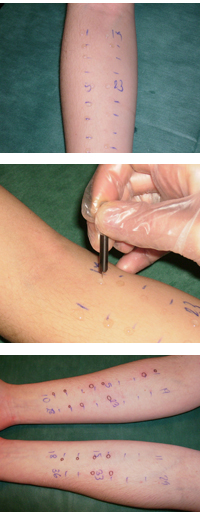Unidad de Inmunología y Alergia Teknon
 Allergen-specific skin tests. For the diagnosis of respiratory and food allergies, skin tests are performed with the "prick" technique and are quick, painless, sensitive, reproducible and practically free of risks for the patient's health. This test consists of applying drops of food extracts or environmental allergens to the arms, followed by a light puncture with a lancet. After 15 minutes, a wheal will form at the point where the allergen to which the patient is sensitive is deposited. The interpretation of this reaction is assessed and explained by the allergist.
Allergen-specific skin tests. For the diagnosis of respiratory and food allergies, skin tests are performed with the "prick" technique and are quick, painless, sensitive, reproducible and practically free of risks for the patient's health. This test consists of applying drops of food extracts or environmental allergens to the arms, followed by a light puncture with a lancet. After 15 minutes, a wheal will form at the point where the allergen to which the patient is sensitive is deposited. The interpretation of this reaction is assessed and explained by the allergist.- Blood and mucous secretion tests. They allow to verify the existence of allergy markers (increase of total immunoglobulin E (IgE)), increase of eosinophilic leukocytes (eosinophilia). It is very important to measure the level of specific IgE antibodies for the allergens detected (mites, pollens, animal epithelia, fungi or food) as they help to confirm and assess the intensity of the allergy.
- Mucosal provocation tests (conjunctival and nasal tests). Using the allergens involved in a controlled manner, in addition to certifying the relationship between exposure to the allergen and symptoms, they can be essential in the study of some types of allergies such as occupational allergies, as well as in the follow-up and evaluation of immunotherapy.
- Epicutaneous tests. Also called "patch test" in which the products to be studied, duly prepared in glycerin, are applied in small quantities on the skin and in an occlusive manner for 48 hours. After this time and up to 72 to 96 hours, readings are taken in search of an inflammatory reaction that can range from a simple redness to the production of blisters. The interpretation of these tests should be careful and always relate them to the clinical history. Products (cream, perfume or cosmetics) related to the appearance of the symptoms can be applied in this test. There are specific batteries according to the work environment (hairdressing, industry, pharmaceuticals) or substances (glues, dyes, cosmetics, etc.) with which the patient comes into contact. Some varieties also require the application of light or UVA rays.
- Spirometry and bronchodilation test. This test evaluates the bronchial capacity of the patient and the affectation that diseases such as asthma, chronic cough, bronchitis or chronic obstructive pulmonary disease cause in it. It is used to check pulmonary function during asthma treatment and during crises. It consists of blowing through a spirometer after a deep inspiration. Subsequently, an aerosol bronchodilator is inhaled to repeat the same maneuver 15 minutes later.
- Metacholine or bronchial hyperreactivity test. Through this test it is possible to know if the bronchi may suffer a bronchospasm due to a non-specific stimulus such as viruses producing respiratory infections, physical exercise or environmental irritants. It is a useful tool to rule out bronchial asthma, in the study of chronic or persistent cough and in the diagnosis of occupational or exertional asthma. This test consists of performing spirometry after inhalation of a drug at different concentrations, to detect a decrease in the ability to blow at the first second. This test is performed under controlled conditions.
- Exhaled Nitric Oxide Measurement. This non-invasive test is aimed at evaluating the degree of bronchial inflammation in respiratory diseases such as allergic and non-allergic asthma, as well as the good response to its treatment with inhalers. It also helps to know when to stop this medication. It consists of blowing for 10 seconds through a nitric oxide detector, a gas that is produced more in situations of airway inflammation
- Drug allergy testing
The diagnosis of drug allergy involves a process that varies according to the type of drug involved and combines several types of tests. At present there is no test that rules out allergy to all drugs at the same time due to their immense variety.
Once the specific and exhaustive clinical history has been taken, which is essential in these cases, it will be determined whether the patient suffers from other types of allergies and a blood test will be requested in search of specific allergy markers. In the case of beta-lactams (penicillin and derivatives) and some other drugs, the existence of specific IgE antibodies or specifically sensitized cells will be determined by means of specialized analysis.
In most cases, in vivo tests must be performed to confirm the diagnosis. These tests can be performed on the patient's skin or completed by means of a controlled progressive challenge test. In this case, the tests must be performed under strict medical supervision and in a hospital setting, since they involve a risk to the patient's health, who must be duly informed and asked to agree to the test being performed.
An important purpose of these tests is also to determine which alternative drugs can be taken safely.
| Morning | Afternoon | |
|---|---|---|
| Monday | 9.00 - 19.30 h | - |
| Tuesday | 9.00 - 19.30 h | - |
| Wednesday | 9.00 - 19.30 h | - |
| Thursday | 9.00 - 19.30 h | - |
| Friday | 9.00 - 14.00 h | - |















